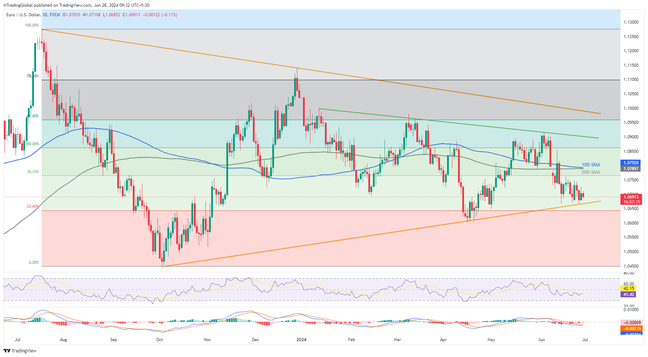EURUSD struggles to defend the first weekly gain in four as sellers appear more inclined to revisit an upward-sloping support line from early October 2023. That said, the Euro pair’s failure to keep Thursday’s rebound from the stated support line joins the bearish MACD signals to keep sellers hopeful ahead of the US Federal Reserve’s (Fed) preferred inflation gauge, namely the Core PCE Price Index. However, a daily closing beneath the aforementioned key technical support surrounding 1.0665 becomes necessary for the bears to tighten their grip. Following that, the quote becomes vulnerable to slump toward the yearly low marked in April around 1.0600. In a case where the downbeat RSI conditions and the stated 1.0600 support fail to stop the sellers, the prices could well aim for the year 2023 to bottom close to 1.0450.
Meanwhile, EURUSD recovery remains elusive unless it stays beneath a convergence of the 200 and 100 SMAs, close to 1.0790 by the press time. That said, the 1.0750 and the 1.0800 thresholds are extra upside filters to watch during the quote’s fresh rise in case of the downside US data. It’s worth noting that the Euro pair’s successful run-up beyond 1.0800 will enable buyers to aim for the 50% Fibonacci retracement of late 2023 fall, around 1.0865, but a descending trend line from early January 2024, close to 1.0900, will challenge the upside afterward. Even if the quote manages to remain firmer past 1.0900, an 11-month-long falling resistance line near 1.0990 and the 1.1000 psychological magnet will be tough nuts to crack for the bulls.
Overall, EURUSD bears keep the reins ahead of the key US data but the quote’s further downside hinges on the strong US inflation clues and a clear break of the 1.0665 support.
Join us on FB and Telegram to stay updated on the latest market events.

